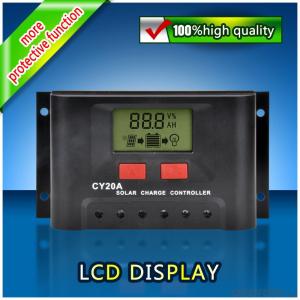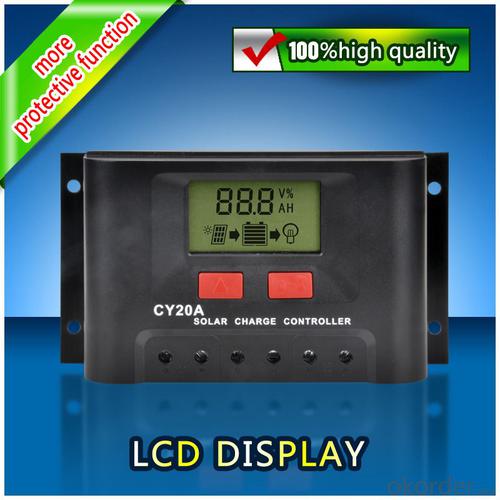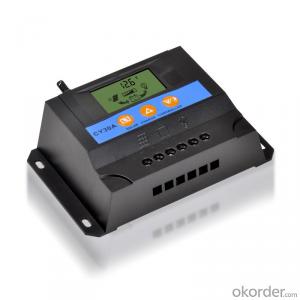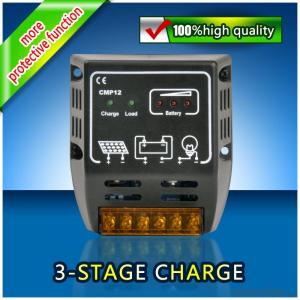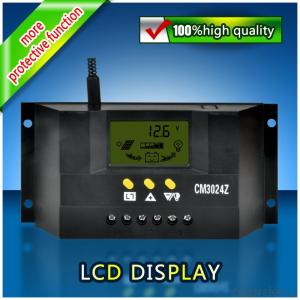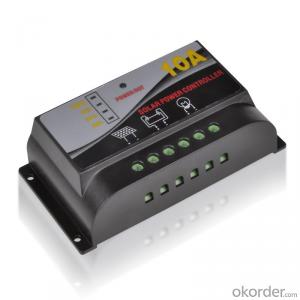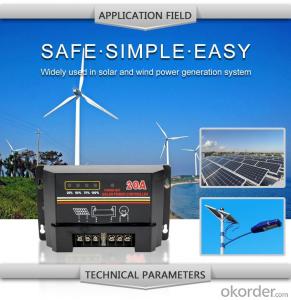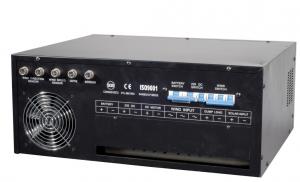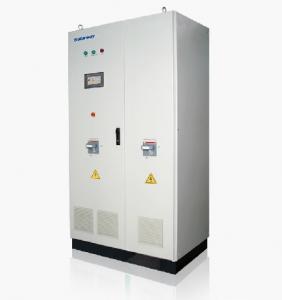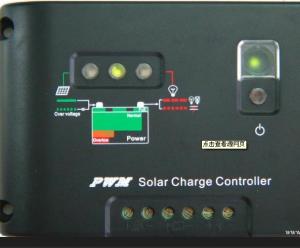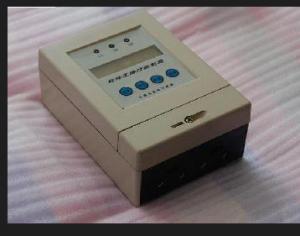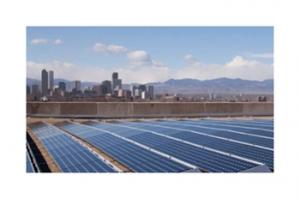Pentair Solar Poll Controllers - Solar LCD Controller CY20A with the Best Price
- Loading Port:
- China main port
- Payment Terms:
- TT or LC
- Min Order Qty:
- 1 unit
- Supply Capability:
- 10000 unit/month
OKorder Service Pledge
OKorder Financial Service
You Might Also Like
Product Introduction
Solar controller is control device which can control solar panel and transform solar energy into electricity then store to the battery bank. Solar controller is the most important part in offgrid system, whose performance has much effect on life expectancy and operation of the whole system, especially the battery expectancy.
Application Areas
Standalone Photovoltaic power station
Standalone Domestic household photovoltaic power system
Mobil communication base stations, expressway and other non-residential regions.
Coastal islands, remote mountainous, border posts for regions shortage of or without electricity.
Government demonstration projects, landscape lighting project etc.
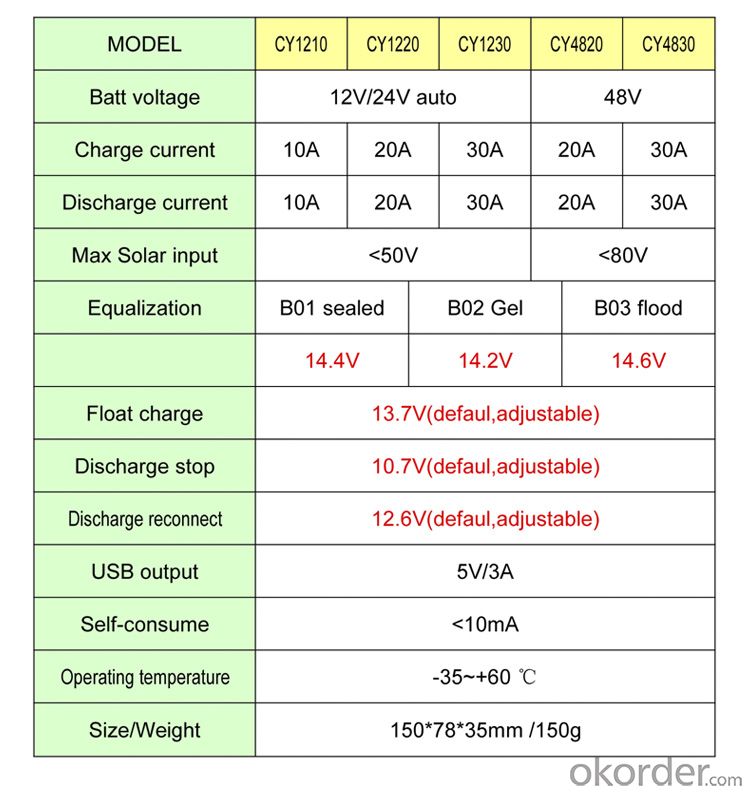
Selection of high-quality materials properties be consistent from beginning to end
For life is a convenient
A little more secure
The innovation design idea of the perfect show
The first set of people-oriented
The high-end configuration components
- Q: Can a solar controller be used with a solar-powered hospitality industry?
- Yes, a solar controller can be used with a solar-powered hospitality industry. A solar controller is a crucial component in a solar power system as it manages the flow of energy between the solar panels, batteries, and appliances. In a hospitality industry, where energy consumption is significant, a solar controller can effectively regulate and optimize the energy generated by the solar panels, ensuring a reliable and sustainable power supply for various applications such as lighting, heating, cooling, and other electrical equipment.
- Q: Can a solar controller be used with solar-powered marine systems?
- Yes, a solar controller can be used with solar-powered marine systems. A solar controller helps regulate the charging process of the batteries in a solar-powered system, ensuring optimal charging and preventing overcharging or damage to the batteries. This is beneficial for marine systems as it helps to efficiently harness solar energy and extend the battery life, making it a suitable choice for powering various equipment onboard boats or other marine vessels.
- Q: Can a solar controller be used with solar panels that are connected to an inverter?
- It is possible to utilize a solar controller with solar panels that are linked to an inverter. The solar controller, also referred to as a charge controller, plays a vital role in regulating the voltage and current generated by the solar panels. Its purpose is to prevent overcharging and damage to the batteries or connected equipment. Typically, the solar controller is positioned between the solar panels and the battery bank or inverter. When solar panels are connected to an inverter, the inverter functions by converting the direct current (DC) produced by the solar panels into alternating current (AC). This converted current can be utilized to power household appliances or can be fed back into the grid. Despite this setup, the solar controller can still be utilized to ensure proper charging and maintenance of the batteries, if present, or to regulate the power flow to the inverter. The solar controller will diligently monitor the battery voltage and make adjustments to the charging parameters accordingly. This guarantees efficient and safe charging of the batteries. Furthermore, it safeguards the batteries from potential issues such as overcharging, over-discharging, and more. In addition to these fundamental functions, certain solar controllers offer supplementary features including load control, battery temperature compensation, and remote monitoring. Therefore, it is highly recommended to utilize a solar controller when using solar panels connected to an inverter. This practice optimizes the performance and lifespan of the system, particularly when batteries are involved.
- Q: How do I calculate the maximum power handling capacity for a solar controller?
- In order to determine the maximum power handling capacity of a solar controller, several important factors should be taken into consideration. Firstly, it is advisable to review the solar controller's specifications to check if there is a maximum power handling capacity rating provided. Typically, this rating is expressed in watts (W) or amperes (A). If such information is available, it can be directly utilized as the maximum power handling capacity. If the rating is not explicitly stated, an alternative method to calculate the maximum power handling capacity is by employing the formula P = V * I. Here, P represents power in watts, V symbolizes voltage in volts, and I signifies current in amperes. To ascertain the maximum current rating, reference to the solar panel's specifications should be made, specifically noting the maximum current output. It is important to bear in mind that the solar panel's maximum current output may vary depending on factors such as temperature and sunlight intensity. Furthermore, it is essential to determine the voltage at which the solar controller operates. This information can be found within the solar controller's specifications. Once both the maximum current and voltage values have been obtained, their multiplication will yield the maximum power handling capacity. For instance, if the solar panel's maximum current output is 5A and the solar controller's operating voltage is 12V, the maximum power handling capacity would amount to 5A * 12V = 60W. It is advisable to opt for a solar controller with a power handling capacity slightly exceeding the maximum power output of the solar panels. This ensures some leeway and guarantees that the solar controller can effectively manage the peak power generated by the panels, avoiding system overload or damage.
- Q: Can a solar controller be used with a solar-powered GPS tracker?
- Yes, a solar controller can be used with a solar-powered GPS tracker. A solar controller is responsible for regulating and optimizing the power output from a solar panel, ensuring that the connected device, such as a GPS tracker, receives the appropriate voltage and current. By using a solar controller, the solar-powered GPS tracker can effectively harness solar energy and extend its battery life.
- Q: How do I connect a solar controller to my solar panels?
- To connect a solar controller to your solar panels, follow these steps: 1. Determine the appropriate location for the solar controller near your solar panels, preferably in a cool and dry environment. 2. Identify the positive (+) and negative (-) terminals on both the solar panels and the solar controller. 3. Connect the positive terminal of the solar panel to the positive terminal of the solar controller using appropriate cables or connectors. 4. Similarly, connect the negative terminal of the solar panel to the negative terminal of the solar controller using cables or connectors. 5. Ensure all connections are secure and tight to prevent any loose connections or potential damage. 6. Once connected, double-check the wiring to ensure it is correct and there are no loose or exposed wires. 7. Finally, refer to the manufacturer's instructions for any additional steps or specific settings that may need to be adjusted on the solar controller. Remember to exercise caution and consider seeking professional assistance if you are unsure about the process or lack the necessary expertise in electrical installations.
- Q: What is the purpose of a solar controller in a solar power system?
- The purpose of a solar controller in a solar power system is to regulate and control the flow of electricity between the solar panels and the batteries. It ensures that the batteries are charged efficiently and prevents overcharging, over-discharging, and damage to the batteries. Additionally, the solar controller helps in maximizing the overall performance and lifespan of the solar power system.
- Q: How does a solar controller handle short-circuit conditions?
- A solar controller is designed to regulate and control the charging process of solar panels to ensure the optimal performance and safety of the system. When it comes to short-circuit conditions, the solar controller employs various mechanisms to handle such situations. Firstly, a solar controller typically incorporates short-circuit protection features. These features are often in the form of internal fuses or circuit breakers that are designed to trip or open the circuit in the event of a short circuit. This helps to prevent excessive current flow that could potentially damage the solar panels or other connected components. Additionally, the solar controller may also include overcurrent protection mechanisms. These mechanisms work by monitoring the current flowing through the system and automatically reducing or cutting off the current when it exceeds a predetermined threshold. This helps to prevent damage to the solar panels or other components in the event of a short circuit. Furthermore, some advanced solar controllers utilize microprocessors or microcontrollers to monitor and analyze the system's conditions. These microprocessors are programmed to detect short-circuit conditions by continuously monitoring the voltage and current levels. In the event of a short circuit, the microprocessor can quickly respond by shutting down the charging process or activating the short-circuit protection mechanisms. Overall, a solar controller is equipped with various protective measures to handle short-circuit conditions. These measures include short-circuit protection features such as fuses or circuit breakers, overcurrent protection mechanisms, and advanced monitoring systems. By employing these mechanisms, the solar controller ensures the safety and longevity of the solar panels and the entire solar power system.
- Q: What is the role of a solar controller in preventing electrical surges in the solar panel system?
- The role of a solar controller in preventing electrical surges in the solar panel system is to regulate and control the flow of electricity between the solar panels and the batteries or the grid. It ensures that the voltage and current levels are kept within safe limits, preventing any sudden spikes or surges that may damage the system components. The solar controller also provides protection against overcharging or over-discharging of batteries, safeguarding the overall system from potential electrical surges.
- Q: Can a solar controller be used with solar panel window mounts?
- Yes, a solar controller can be used with solar panel window mounts. A solar controller regulates the charging and discharging of the batteries connected to the solar panels. It is compatible with different mounting options, including window mounts, as long as the solar panels are properly connected to the controller.
Send your message to us
Pentair Solar Poll Controllers - Solar LCD Controller CY20A with the Best Price
- Loading Port:
- China main port
- Payment Terms:
- TT or LC
- Min Order Qty:
- 1 unit
- Supply Capability:
- 10000 unit/month
OKorder Service Pledge
OKorder Financial Service
Similar products
Hot products
Hot Searches
Related keywords
